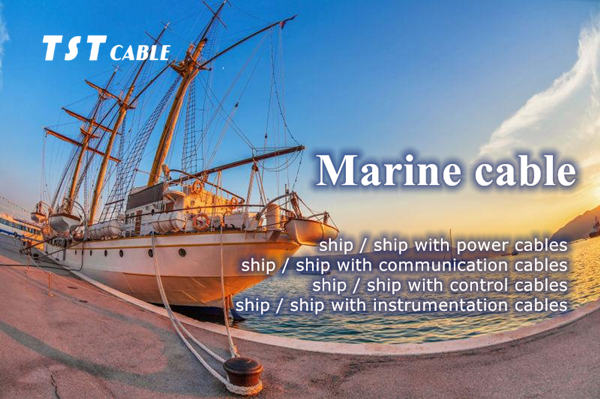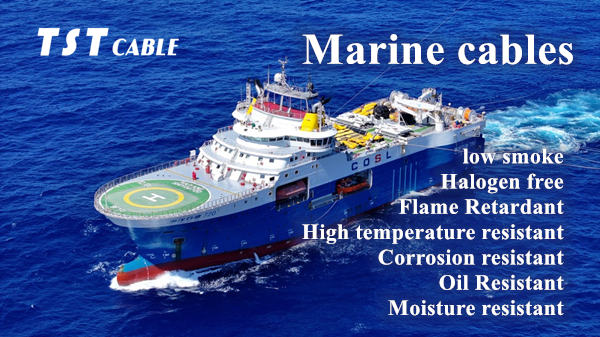Introduction to marine special cables
Marine control cable is all kinds of ships, offshore oil platforms and buildings on the water power, lighting, control, communications, microcomputer systems such as special wires and cables. Due to the use of harsh environmental conditions, the cable is required to be safe, reliable, long life, small size, light weight, and has excellent temperature resistance, high temperature and high pressure, vibration resistance, fire resistance, flame retardant, oil resistance, moisture resistance, seawater corrosion resistance, excellent electrical and mechanical properties and other requirements.
Ship type and use: different types and uses of ships need different kinds of special cables, such as cargo ships, oil tankers, passenger ships and so on.
Ship’s working environment: the marine environment has higher requirements for cables, which need to have good water resistance, corrosion resistance and other characteristics.
Safety standards: ships as a special carrier, its safety requirements are very high, so marine special cable needs to meet the relevant safety standards and certification requirements.

Commonly used standards for marine special cables:
IEC 60092 series: The International Electrotechnical Commission (IEC) issued a series of standards for marine electrical equipment, including IEC 60092-350 “marine cables” and other sub-standards, covering the design, construction and testing of marine cables.
IEEE 45: The American Institute of Electrical and Electronics Engineers (IEEE) issued the “Marine Electrical Safety Standard”, which includes the requirements for marine electrical systems and equipment, the design and application of marine special cables to provide guidance.
NEK 606: Marine Cable Standard issued by the Norwegian Electrical Standards Committee, which covers the design, manufacture and installation of marine cables and is mainly applicable to ships in the Nordic region.
BS 6883: Marine cable standard issued by the British Standards Institution, for marine special cable flame retardant performance, fire resistance, oil resistance and other requirements.
DIN VDE 0250 series: the standard for marine cables issued by the German Electrical Engineers Association, including the design, testing, marking and other requirements for marine cables.
JIS C 3410: Marine cable standard issued by Japan Industrial Standards Association, applicable to the design and manufacture of Japanese marine cables.
GB/T 13033 “Marine Cables”: This is a standard on marine cables issued by the National Standardization Committee of China, covering the classification, requirements, test methods, etc. of marine cables.
GB/T 18380.5 “Marine Electrical Equipment for Offshore Vessels and their Equipment Part 5: Cables”: This is one of the series of standards on marine electrical equipment issued by China National Standardization Committee, covering the requirements and test methods for marine cables.
CCS Code: The ship construction and inspection codes issued by China Classification Society (CCS) contain requirements for marine cables, which are generally in line with international standards and industry practices.
CB/T 4951 “Marine Control Cables”: This is one of the control standards for marine cables in China, which specifies the technical requirements, test methods and other contents of marine control cables.
CB/T 4973 “Marine Power Cables”: this is one of the power standards for marine cables in China, stipulating the technical requirements, test methods and other contents of marine power cables.
These standards usually cover the design, materials, manufacturing process, test methods, marking and installation requirements of marine special cables to ensure that marine cables can operate safely and reliably in the harsh environment at sea. When designing and manufacturing ships, these standards are usually referred to in order to select and use suitable marine special cables.
Control cables for marine vessels Basic parameters
Conductor: Multi-stranded stranded filament conductor, in accordance with VDE 0295 and IEC 60288 Class 2 or Class 5 conductor.
Insulation: special PVC insulated core
Cable formation: concentric stranding of cores
Sheath: special PUR (TMPU) (polyurethane) outer sheath, DIN
Shielding: Aluminum foil + bare copper braid shielding
Rated voltage: 250V (special specifications can be produced according to customer requirements)
Operating temperature: 85℃ (special specifications can be produced according to customer requirements)
Standard cross-section: (special specifications can be produced according to customer requirements)
Diameter core number: multi-core (special specifications can be produced according to customer requirements)
Classification of marine control cables for offshore vessels:
From the type of points, marine cables can be divided into two categories: (civil) marine wire and cable, (military) ship with wire and cable.
From the use of points, marine cables can be divided into three categories: ship / ship with power cables, ship / ship with communication cables, ship / ship with control cables, ship / ship with instrumentation cables.
Their roles are:
Ship/ship power cables: used to transport power supply on the ship, such as host cable, generator cable, etc..
Ship/ship communication cables: used for the connection of internal communication system of the ship, such as telephone cables, data cables, etc.
Ship/naval control cables: cables used to control various equipment and systems on ships, such as cockpit control cables, sensor connection lines, etc.
Instrumentation cables for ship/ship: cables used for connecting various instruments and monitoring equipment of the ship, such as instrumentation connecting lines, sensor cables and so on.
The selection steps and principles of each cable in the ship’s power system:
1, according to the use of the cable, laying location and working conditions to choose the appropriate cable type.
2, according to the working system of power equipment, power supply type, cable core and load current select the appropriate cable cross-section.
3, according to the results of the system short-circuit current calculations, the short-circuit capacity of the piece of broken cable to meet the requirements.
4, according to the ambient temperature of the cable rated current-carrying capacity correction, and then determine whether the allowable current of the cable is greater than the load current.
5、 Correct the rated current-carrying capacity of the cable according to the correction coefficient of bundled laying, and then determine whether the allowable current of the cable is greater than the load current.
6、 Calibrate the line voltage drop and judge whether the line voltage drop is less than the specified value.
7、According to the setting value of the protection device, judge whether the cable is coordinated with the protection device; if it is not coordinated, judge whether it is possible to change the appropriate protection device or setting value, otherwise, the appropriate cable loading surface should be re-selected.
TSTCABLES Marine cable characteristics and applications are different from ordinary cables, mainly in the following aspects:
Water resistance: Marine cables need to have good water resistance to be able to be used for a long time in a humid marine environment.
Corrosion resistance: Since seawater contains a lot of salt and corrosive substances, marine cables need to have good corrosion resistance to ensure long-term stable work.
High temperature resistance: some equipment inside the ship may produce high temperature, marine cable needs to be able to work for a long time under high temperature environment without damage.
Fire resistance: ships as a special carrier, its fire resistance requirements are high, marine cables need to have good flame retardant properties to ensure that the ship fire can be extinguished in time to reduce casualties and property losses.
Marine control cables
About marine control cable price
1: The prices on this website are the reference price for the release of product information, all wire and cable prices should refer to the copper price of the day.
2: There are large quantities of procurement of enterprises, according to the amount of orders used, the specific bulk price can be communicated with the account manager, signed a long-term cooperation agreement.
Quality Assurance
All TSTCABLES offshore marine control cable products before leaving the factory, we have done a good job of self-inspection and finished product inspection, to avoid the problem phenomenon to the customer site, wholeheartedly based on the global market, customer service.
Also available in:
English


